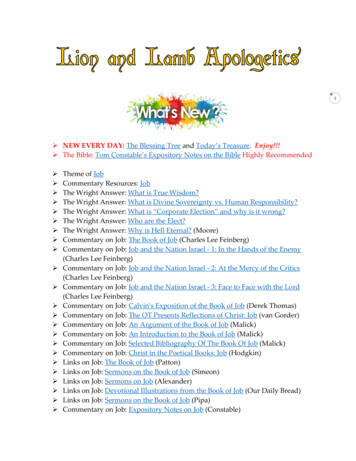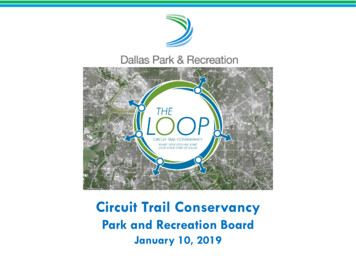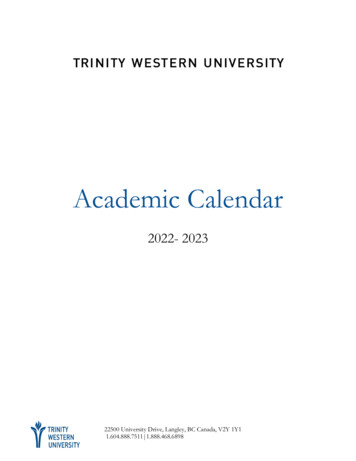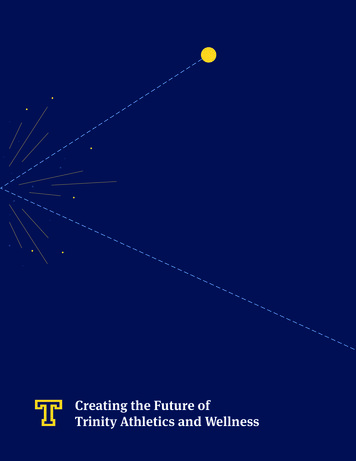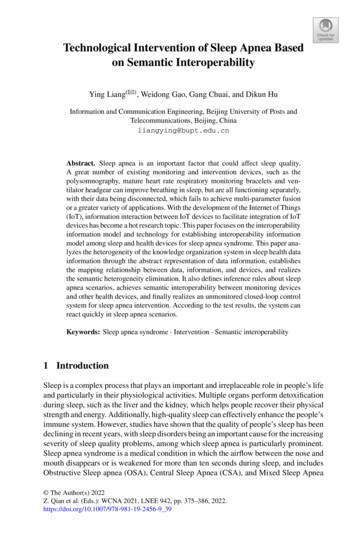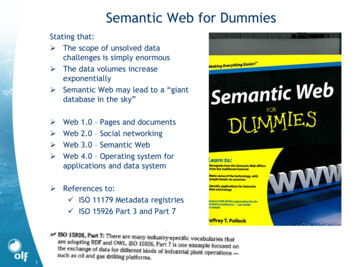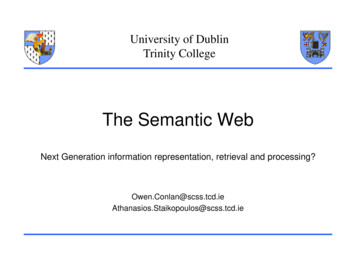
Transcription
University of DublinTrinity CollegeThe Semantic WebNext Generation information representation, retrieval and opoulos@scss.tcd.ie
Agenda Syntax vs SemanticsData on the WebSemantic WebSemantic Web TechnologiesVocabulariesLinked Data
Semantics is Provide a well defined meaning, that computers can processBut for us:Semantics “a representation of the linkbetween a term in a statementto the entity in the world that the term refers to” p31, Semantic Web for the Working Ontologist
Semantics vs Syntax Semantics a way of encoding meaning (link betweenterm and a model of the world). Good for building applicationsSyntax a way of encoding terms so that they can bedistinguished, structured, grouped and related toeach other in a grammar. (Symbolic representation) Good for building parsersNote! We need a syntax (or syntaxes) for expressing a machine-readablesemantics. (RDF is the candidate syntax for the Semantic Web)
Limitations of current approachesStructured Information (files, databases ) interrelationships in structure is “implicit” easier to deal with computers, designed primarily for humaninterpretation e.g. patient table: name, surname, age, prescriptionUnstructured Information (web documents ) information retrieval/querying based on “clever pattern matching”and human interpretation interrelationships of information based on “context” of documentplacement e.g. retail website
Evolution of World Wide Web
Traditional Web Web of documents – processed by humans Typical uses of the Web are information seeking,publishing, searching for people and products, shopping Dynamic pages generateddoc 1doc 4based on information fromdatabases but withoutoriginal informationstructure found indoc 5doc 2databases.doc 3doc 6
Limitations of the Web Search Currently, users search for data on the Web askingquestions like “which documents contain these wordsor phrases”Limitations The Web search results are of low precision. Results are highly sensitive to vocabulary. Results are single Web pages. Most of the publishing contents are not structured toallow logical reasoning and query answering.
Data on the Web Web has made Data available Easy publication An infrastructure for retrieving and representing documents An infrastructure for accessing data There are more and more data on the Web government data, health related data, general knowledge,company information, flight information, sports, weather,news, restaurants, More and more applications rely on the availability ofthat data
Data on the Web is not enough Next step is semantic interoperation Understanding what the data meansLinking in insightful waysAutomated support for data integrationDevelop Smart applicationsSharing data Sharing meaning Need a proper infrastructure for a real Web of Data data is available on the Web - accessible via Webtechnologies and standards data are interlinked over the Web data are integrated over the Web This is where Semantic Web technologies come in
Interconnected web of datathe need for a knowledge driven approachIncreasingly the boundary between data in enterprisesystems, personal devices and on web is becoming blurred
Semantic Web“The Semantic Web is an extension of the current webin which information is given well-defined meaning,better enabling computers and people to work in cooperation.”[Berners-Lee et al, 2001]Semantic Web is a web of datathat machines can “understand” too.
Difficulties for the Semantic Web Current Web represents information using naturallanguage, graphs, pictures, tables, multimedia, Humans can process and combine these informationeasily But, machines: cannot use partial (or incomplete) information have difficulties combining several sources ofinformation can read but cannot “understand” information
Example: Organising a trip Imagine you want to organise a trip using the web You try to find a proper flightYou have to find a hotel – cheap, luxuryYou have to trust the specialised siteYou may want to know something about the place (photographs,maps, itineraries) Usually there is a need to Consult a large number of sites You have to mentally integrate all these information It is a long and tedious process
Semantic Web Technologies A collection of standard technologies to realise the Webof Data – make the integration possible Structured Web Documents (XML, XSD)Describe Web Resources (RDF)Web Ontology Languages (OWL)Rule Languages (RIF, RuleML, SWRL)Reasoning on the Semantic Web: reasoning tools (e.g. Jena)Searching - Query language (SPARQL)Storing the Semantic Web: Repositories (e.g. Sesame)Semantic Web Services (OWL-S, WSMO)Intelligent Software AgentsTrust and BeliefSocial WebApplications
Stack Architecture for Semantic Web
Structured Web Documents XML is used to encode documents (e.g. knowledgebases) - provides the means to serialising structureddocuments It provides user definable and domain specific mark up(tags) XML Schema: determines the syntax (structure) of thedocument There is no commitment On domain specific vocabulary to be used Ontological modelling primitives (is a kind of)
Example ?xml version '1.0' encoding 'ISO-8859-1' standalone 'yes' ? doc type "book" isbn "1-56592-796-9" xml:lang "en" title A Guide to XML /title author Norman Walsh /author chapter title What Do XML Documents Look Like? /title paragraph If you are [.] /paragraph ol item paragraph The document begins [.] /paragraph /item item paragraph Empty elements have [.] /paragraph paragraph In a very [.] /paragraph /item /ol section [.] /section [.] /chapter chapter [.] /chapter /doc
Describing Web Recourses Resource Description Framework (RDF) is a frameworkfor describing and interchanging metadata (datadescribing the web resources - anything on the Web) Statements are expressed as triples: a labelledconnection between two resources or[subject predicate object] RDF can integrate information from multiple resources URIs form the basis of identifying and joining graphs RDF graphs can be serialised in multiple ways (most commonly XML) RDF provides machine understandable semantics better precision in resource discovery than full text search interoperability of metadata
Example RDF Triples as en Conlanfoaf:based neardbpedia:populationUrbandbpedia:Dublin 1110627unv:Person1234 http://www.scss.tcd.ie/owen.conlandbpedia:Dublin http://dbpedia.org/resource/Dublin
Ontologies Encoding data as graph covers only parts of the meaningof the data More elaborate constructs are needed An ontology is a specification of a conceptualization It describes the common concepts (vocabulary) andrelationships between concepts - represents an area ofknowledge (see RDFS and OWL) There should be a compromise between rich semantics for meaningful applications feasibility, implementability
Example
Logic and Inference Logic is the study of systems of reasoning - drawingconclusions First-order logic: the logic of individual things Second-order logic: the logic of types and relationships – can becomplex and computational intensive Logic plays many different roles for the Semantic Web Applying and evaluating rulesInferring facts that haven’t been explicitly statedExplaining why a particular conclusion has been reached (trace)Detecting contradictory statements and claimsKey role in the statement of queries
Logic and Inference The rules take the formIF logical conditions are met THEN perform specified actions (this kind of rules used by so-called expert systems) Evaluating the truth of the logical conditions involveslogic. Rules are often chained together A processor can work backward from one condition towork out what had to happen to get there What is needed A web compatible language for expressing rules (standard) Be able to specify among rules relationships and constraints Tools/Engines to handle the rules and reason about the data
Rules Some conditions may be complicated in ontologies (ie,OWL) - For example combine predicates and rules Enhance expressivity Easier to read and write rules with a rule languagePerson(?p) hasSibling(?p, ?s) Man(?s) - hasBrother(?p, ?s) RuleML – is a family of XML rule-languages for publishingand sharing rules on Web Focus on interoperation between standards SWRL (Semantic Web Rule Language) is a rule languagefor the Semantic Web, combines ontologies and rules Rules are expressed in terms of OWL concepts SWRL rules have the form of an implication between anantecedent (body) and consequent (head)
Searching SPARQL is a query language of the Semantic Web - getinformation from RDF graphs Is a declarative query language (similar to SQL)Based on pattern matching against the RDF graphextract information - e.g. triples, URIs, plain and typed literalsconstruct new RDF graphs from the queried graphs Different types of graph patterns are supported Basic, Group, Optional, Alternative, Named, Constraints Matching a triple pattern (subject, predicate, object) to agraph: bindings between variables and RDF Terms?book dc:title ?title
Storing the Semantic Web: Repositories Semantic Web creates a wealth of data. Keeping them inone big text (e.g.Turtle or RDF/XML) is not the mostefficient option (e.g. data are not indexed) Need for semantic repositories to support the efficientmanipulation of Semantic Web data An RDF store holds place for storing the RDF datamodelas a sequence of: s (subject), p (predicate), o (object) tools that combine the characteristics of database managementsystems (RDBS) – efficient storage, querying, management inference engines – allow reason about the data Example of a Semantic Repository Engine Sesame: most popular semantic repository that supports RDF(S)and all the major syntaxes and query languages related to it
Semantic Web Services A web service is a network accessible interface thatexposes the application functionality Once it is deployed, other applications (and other Web services)can discover and invoke It is implemented by using standard technologies (WSDL, REST) Clients do not need to know how it is implemented Web Services connect computers and devices with eachother using the Internet to exchange data and combinedata in new ways. However, all these service descriptions are based onsemi-formal natural language descriptions. There is a need to make Web Services an automatedtechnology by adding semantic web technology
Semantic Web Services Semantic Web Services are Web Services with a formaldescription (semantics) that can enable a betterdescription, discovery, selection, invocation, composition,monitoring, and interoperability. see Semantic Markup for Web Services (OWL-S)http://www.w3.org/Submission/OWL-S/ Processes are created from the composition of WebServices and/or other components and allow to carry outmore complex tasks such as e-commerce businessactivities
Intelligent Software Agents An agent is a computer system that is situated in someenvironment and that is capable of some autonomousaction in order to meet its design objective“An autonomous agent perceivesits environment via sensors andacts upon that environmentthrough its actuators” There are different classifications such aso Reactive agentso Belief-desire-intentions agentso Goal based agentso Learning agents
Intelligent Software Agents Agents are capable of interacting with other agents byexchanging data and they can engage with other agentsin some social activities such as coordination,cooperation, negotiation etc Semantics are needed to Support Agent communication, negotiationSeek informationInterpret Concepts/VocabularyRepresent Logic
Proof & Trust Trust is largely confined to Identity Identity is usually established via digital certificates andauthentication A digital certificate is a digital form of identification. Itprovides information about the identity of an entity. Proof: that an answer found in the semantic Web iscorrect How – derived from logic By whom – chain of providers
Semantic Technologies forUnstructured DataThey are related to Natural-language processing, InformationRetrieval and Extraction Entity extraction – (people, places, events, dates) Cluster analysis – group related information whererelationships are unknown Classification – map to specific categories Dependency identification – rule generation Coreference resolution – two or more expressions in atext refer to the same entity Automatic Summarization – identify key concepts andkey sentences Example Tools: GATE (General Architecture for Text Engineering)
Social Web Provides new structures and abstractions on top of thetraditional Web allowing people to connect andcommunicate via the Internet They are characterised Community – they allow people (contributors) to collaborate andshare information easily. (Wikipedia, blogs) Mashups - Integrating Web Resources in new ways. (housing Google maps). Social Networking Sites (SNS) For example Facebook, LinkedIn, Twitter, YouTube Allow us Explore trending topics, discover what people are saying, analysefans/followers, examine friendships, cluster colleagues, analysewho is talking to whom, how often, common interests,
Examples of Semantic Applications Semantic Web search EngineseBusiness, eCommerceeGovernmentHealth-care and Life ScienceseLearningeCultureMedia Management (e.g. BBC)Supply Chain Management
Vision
Vocabularies RDFS makes it possible to define vocabularies: collection of properties and classes relationships among those and to terms in other vocabularies Examples include Dublin CoreFOAFOrganisationsGood Relations (ecommerce)RSS (Rich Site Summary)Vcard
Dublin CoreThe Dublin Core Metadata Initiative is an open forum engaged in the development of interoperableonline metadata standards that support a broad range ofpurposes and business modelsProperties in the /terms/namespace abstract, accessRights, accrualMethod, accrualPeriodicity,accrualPolicy, alternative, audience, available, bibliographicCitation,conformsTo, contributor, coverage, created, creator, date,dateAccepted, dateCopyrighted, dateSubmitted, description,educationLevel, extent, format, hasFormat, hasPart, hasVersion,identifier, instructionalMethod, isFormatOf, isPartOf,isReferencedBy,isReplacedBy, isRequiredBy, issued, isVersionOf, language, license,mediator, medium, modified, provenance, publisher, references,relation, replaces, requires, rights, rightsHolder, source, spatial,subject, tableOfContents, temporal, title, type, valid
Dublin Core Example ?xml version "1.0"? rdf:RDFxmlns:rdf :dc "http://purl.org/dc/elements/1.1/" rdf:Description rdf:about "http://www.scss.tcd.ie/Owen.Conlan/" dc:title Dr. Owen Conlan’s Home Page /dc:title dc:creator Owen Conlan /dc:creator dc:publisher SCSS, University of Dublin /dc:publisher /rdf:Description /rdf:RDF
Friend of a Friend (FOAF)http://xmlns.com/foaf/spec/ is a machine-readable ontology describing persons,their activities and their relations to other people
Friend of a Friend (FOAF) - Example rdf:RDF xmlns:rdf :foaf "http://xmlns.com/foaf/0.1/" foaf:Person foaf:name Peter Parker /foaf:name foaf:gender Male /foaf:gender foaf:title Mr /foaf:title foaf:givenname Peter /foaf:givenname foaf:family name Parker /foaf:family name foaf:mbox sha1sum cf2f4bd069302febd8d7c26d803f63fa7f20bd82 /foaf:mbox sha1sum foaf:homepage rdf:resource "http://www.peterparker.com"/ /foaf:Person /rdf:RDF
abulary/org.html
http://lov.okfn.org/dataset/lovVocabulary Spaces
Linked Data Linked Data lies at the heart of what Semantic Web is allabout: large scale integration of, and reasoning on, dataon the Web. Goal: “expose” datasets on the Web Set links among the data items from different datasets
Is you data 5 star ?“LinkedData” is also a set of principles:1. put things on the Web throughURIs and open license (any format)2. use HTTP, URIs, so that peoplecan look up these names, they aremachine readable (not a scan)3. provide useful information usingstandards – non proprietaryformats (e.g. excel)4. use open standards to identifythings (e.g. RDF)5. include links to other URIs, sopeople can discover more thingsRDF is an ideal vehicle to realize these principles
Linked Data or Open Data? Linked Data is actually linked only when data is ratedwith “5 star” The name “Linked Data” doesn’t make much sensefor the lower rated data. The “3 star“ data is thus interpreted as Open data(one based an open licence and in non-‐ proprietaryformats)
How To Link Data ? Links happen at the instance level cf. Hyperlinks in HTML OWL:SameAs -- equivalence RDF:SeeAlso -- associativeBib:aBook OWL:SameAs DBPedia:aBook
DBPedia Berlin - Examplehttp://dbpedia.org/page/Berlin owl:sameAs /2950159/ Can use one concept list to query another database: ask Geonames about the concept known in DBPedia as Berlin
Linked Data: The WWW database
Linked Data: The WWW database
Some characteristics of Linked Dataand its Applications The datasets are essentially read-only they are curated “out of band”: regularly extractedfrom other databases, changed manually by dataowners, etc The dominating paradigm is to extract data via SPARQLqueries Applications use (very) large datasets via (RDF based)integration
Conclusions Semantics allow a common interpretation/meaning Web Standards facilitate interoperability Data on the Web is a major challenge technologies are needed to use them, to interactwith them, to integrate them Semantic Web technologies, Linked Data principlesand practices, should play a major role in publishingand using Data on the Web
Storing the Semantic Web: Repositories Semantic Web creates a wealth of data. Keeping them in one big text (e.g.Turtle or RDF/XML) is not the most efficient option (e.g. data are not indexed) Need for semantic repositories to support the efficient manipulation of Semantic Web data An RDF store holds place for storing the RDF datamodel


